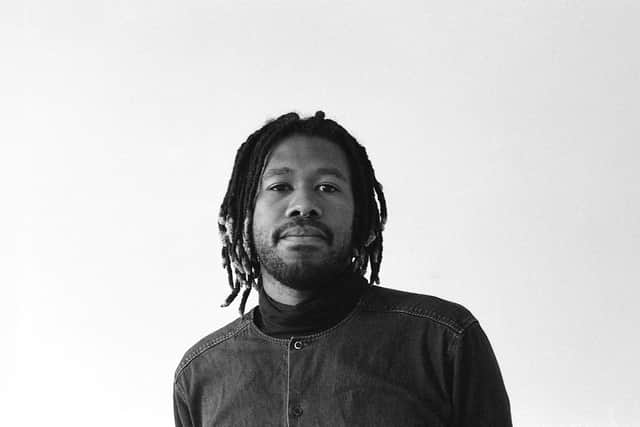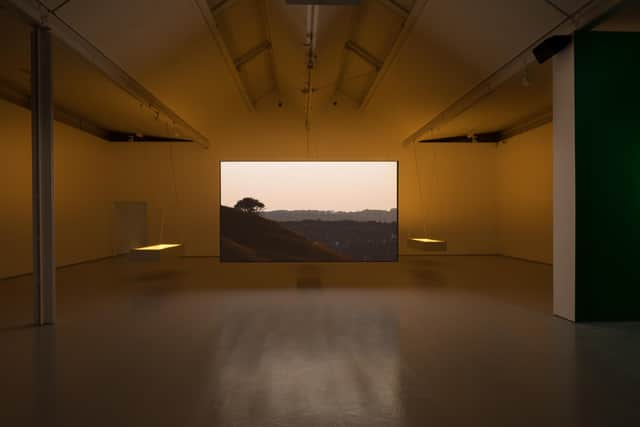Ones to watch in 2024: Matthew Arthur Williams
This time last year, Matthew Arthur Williams had his first major solo exhibition. But his show, Soon Come, at DCA, didn’t feel like a debut. The photographs and film which, quietly but assuredly, occupied the venue’s two galleries displayed the technical aptitude and thoughtful approach of a mature artist.
“I think I had an accumulation of stuff waiting to go,” he says when we meet in his Glasgow studio, a space which he shares with three other artists. The subject matter of Soon Come – his mother’s family’s migration from Jamaica to Stoke-on-Trent – was something he had wanted to explore for a long time. “I wanted to do it ten years ago, but I knew that I didn’t have the skills or the capability to do it justice. I knew there was something there that I would just love to put a magnifying glass on, somehow talk about it in its complexities.”
Advertisement
Hide AdWilliams, 34, speaks softly as if compensating for the fact that, at six foot seven, he towers over most people. Everything he says feels as though it has been the product of careful thought. He has lived in Glasgow for a decade, but didn’t study here; raised in London, he studied photography at Kingston College of Art & Design (2007-09) and Manchester Metropolitan University (2009-12).
Apart from presenting his work occasionally in artist-run spaces, making ‘zines and appearing in group shows like Ambit (2019), Street Level’s showcase of emerging photographers, he has more often been associated with supporting the work of other artists, most notably Alberta Whittle.
The DCA show, however, demonstrated decisively that he had a voice of his own and plenty to talk about. The central film from Soon Come is currently being shown at Gathering in London, and he has a solo exhibition at Stills in Edinburgh in March. A new film “about queerness and this queer history which I’m longing to keep alive” is also in process for a two-person show in early summer at Govan Project Space.
“I don’t like to rush stuff,” he says, quietly, explaining that one reason for moving to Glasgow was the prospect of applying for the Art School’s celebrated MFA – something he has not yet done. (The other reason was meeting his partner, the artist and Margaret Tait Award winner Andrew Black.) “[The DCA show] wouldn’t have been the same if I hadn’t worked in support of other artists in the years before that.”
In fact, he was learning all the time: making a short film with artist Christian Noelle Charles, assisting Black on Dàn Fianais, his film made on Skye for Atlas Arts, working with Whittle on her Margaret Tait Award film Between A Whisper and A Cry, and her made-in-lockdown project RESET. From stills photographer and bag carrier, he graduated to wielding the camera himself. He is also a DJ and sound artist, and worked with Richey Carey to create the soundscape for Whittle’s Venice film, Lagareh.


“I think I always wanted to make moving image from 10, maybe 15, years ago, but I always felt daunted by it. As a photographer who’s in love with analogue photography, I knew I wanted to make analogue moving image, but the expense of picking up an 8mm camera or 16mm camera and making lots of mistakes put me off. If it wasn’t for those projects, I don’t think I would have been able to produce the film that I did.”
Advertisement
Hide AdHowever, still photography remains his anchor, a passion which has been with him since childhood. “My sister and my mum were quite casual but keen photographers, just as a way to record life. My sister is 10 years older than me and her relationship to photography in documenting her life as a teenager and a young adult must have fed into me. The family photo album was always there.
“As you progress as an artist, you add more strings to the bow, but there’s always been a photographic element, I’ve always wanted to push the importance of the photography element in my practice. Even if I end up making a film, or making sound for other people’s work, it’s been informed by a visual understanding of how we read images.”
Advertisement
Hide AdIn a way, Soon Come is a creative revisiting of the family album. In it, he collages elements of his mother’s experience – she left Jamaica in the 1960s as a child when her parents found work in Stoke-on-Trent – with newsreels and archival films, a personal archive laid against a societal one.


Williams says he noticed “pockets of history which didn’t add up. My memory saw a place, a community, but looking back I would think, where did that go? Was I fabricating this big community? But I wasn’t, it just existed in pockets. That spurred on the film.”
He trawled institutional archives in Staffordshire and the West Midlands as much aware of what he didn’t find as what he found; anyone working on black histories becomes interested in omissions. In one photography archive, he searched through images of pottery workers for three days before finding a single black face. “It was an eye-opener in understanding institutions, because archives exist everywhere, but it depends where the value sits.”
Absence and disappearance are also key themes in the new work he is making for Stills, in which he plans to develop the strand of self portraiture which framed the entrance and exit to the DCA show. “I’ve been making self portraits for a long time, but I didn’t understand their value or importance in my practice. I was doing a lot of portraiture, and it became apparent that I needed to turn the camera around, to document myself as well.”
He adds that the black and white images, made in the dark room using highly contrasting light have also been a way to “get really excited by being in the dark room again, really being with the materials, thinking about what is visible, and what I am choosing to zone out or crop into.”
He brings out a diptych to show me. In the first image, he is crouched, naked, like a runner on the starting blocks ready to spring. The second shows the same space, the spotlight, but the frame is empty.
Advertisement
Hide Ad“It’s the act of disappearing. I think a lot of people think of that image as me kneeling or taking the knee, but it’s not that at all, it’s actually me trying to make myself look small – which is quite hard to do when you’re six foot seven. It’s making myself as small and also as solid as possible, and then removing that person from that scene. I think it’s quite a loud image when you’re not there at all.”
Matthew Arthur Williams, Stills, Edinburgh, 22 March until 15 June